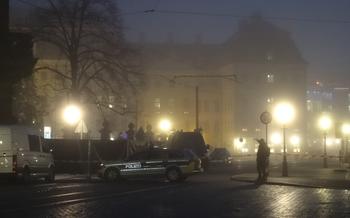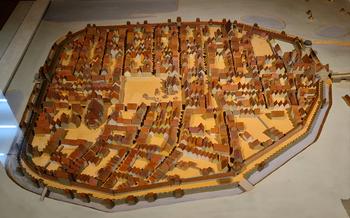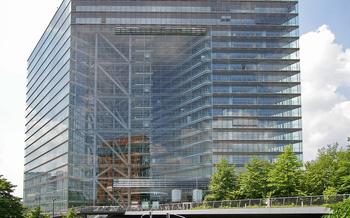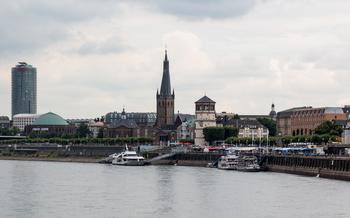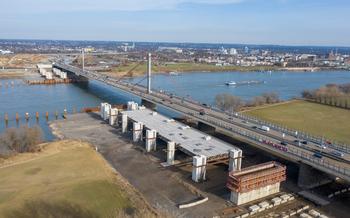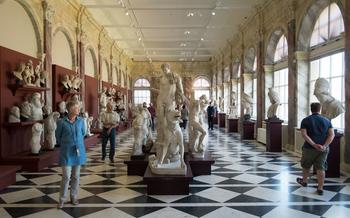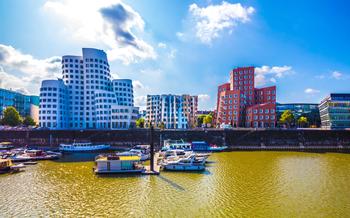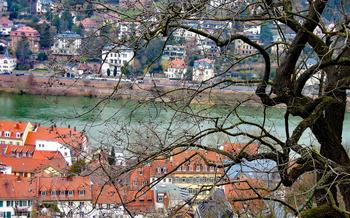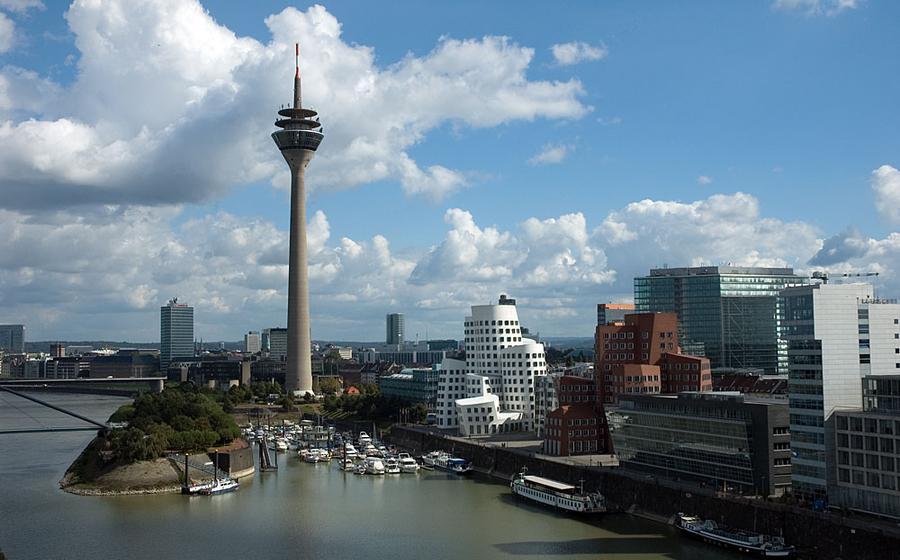
Hetjens Museum (German Ceramic Museum)
- The Hetjens Museum: A Haven of Ceramic Art
- Historical Background and Significance
- Unique Collection of Ceramics from Various Eras and Cultures
- Highlights of the Museum's Collection
- Interesting Anecdotes and Stories
- Ancient Ceramics: A Journey Through Time
- Medieval and Renaissance Ceramics: Art and Function
- The Baroque and Rococo Periods: Elegance and Opulence
- 19th-Century Ceramics: Industrial Revolution and Artistic Revival
- 20th and 21st-Century Ceramics: Modern and Contemporary Expressions
- Special Exhibitions and Events
- Educational Programs and Workshops: Unleashing Your Inner Ceramic Artist
- The Museum Shop: A Treasure Trove of Ceramic Delights
- Accessibility and Visitor Information
- Local Cuisine and Dining Options
- Nearby Attractions and Activities
- Accommodations and Where to Stay
- Insider Tip: Unveiling Hidden Gems
The Hetjens Museum: A Haven of Ceramic Art
Historical Background and Significance
In the heart of Düsseldorf, nestled amidst the vibrant streets of Altstadt, lies the Hetjens Museum, a treasure trove of ceramic art. Founded in 1909 by German industrialist and art collector Laurenz Heinrich Hetjens, this museum has evolved into a world-renowned institution dedicated to the preservation and celebration of ceramics. The museum's rich collection spans millennia, showcasing the diverse artistic expressions and technical innovations that have shaped the world of ceramics throughout history.
Unique Collection of Ceramics from Various Eras and Cultures
The Hetjens Museum boasts a remarkable collection of over 8,000 ceramic pieces, representing a vast array of eras and cultures. From ancient Greek vases to exquisite Chinese porcelain, from medieval pottery to contemporary sculptures, the museum's exhibits offer a comprehensive journey through the history of ceramic art. Each piece tells a unique story, revealing the cultural influences, technological advancements, and artistic styles that have shaped this enduring medium.
Highlights of the Museum's Collection
Among the museum's highlights are the exquisite Roman glass vessels, showcasing the mastery of ancient artisans in manipulating molten glass. The Islamic pottery collection, with its intricate patterns and vibrant colors, represents the flourishing of ceramic art in the Middle Ages. The collection of Meissen porcelain, renowned for its delicate forms and cobalt blue decorations, exemplifies the artistry of the German Baroque period. Visitors can also admire exceptional examples of Japanese ceramics, including tea bowls, vases, and figurines, demonstrating the profound cultural significance of ceramics in Japanese society.
Interesting Anecdotes and Stories
The Hetjens Museum is not just about showcasing artifacts; it is also about sharing stories. One captivating tale surrounds the museum's acquisition of a rare Chinese porcelain vase. Initially dismissed as a fake due to its unusual appearance, the vase was later authenticated as a genuine Ming Dynasty masterpiece. Another intriguing story involves a medieval pitcher that was discovered during the renovation of a local church. Believed to have been used for baptisms, the pitcher offers a glimpse into the religious rituals and customs of the past.
Ancient Ceramics: A Journey Through Time
Ceramics, the art of shaping and firing clay, holds a profound significance in human history, dating back to prehistoric times. The Hetjens Museum's collection of ancient ceramics invites visitors on a captivating journey through the evolution of ceramic techniques and styles.
The museum showcases remarkable examples of ancient pottery from various cultures, each piece narrating a unique story of human creativity and innovation. From intricately decorated Neolithic vessels to finely crafted Greek amphorae, the collection spans millennia of ceramic history.
Notable among the ancient ceramic exhibits is a stunning collection of Egyptian faience, a type of glazed ceramic that was highly prized in ancient Egypt. These vibrant and colorful pieces, often depicting deities or scenes from daily life, offer a glimpse into the rich artistic traditions of ancient Egyptian civilization.
Another highlight is a series of Roman oil lamps, which not only served a practical purpose but also showcased the Romans' artistic flair. These lamps were often adorned with intricate reliefs or mythological figures, reflecting the Romans' fascination with storytelling and symbolism.
The Hetjens Museum's collection of ancient ceramics is not merely a display of artifacts but a testament to the enduring legacy of human craftsmanship. These pieces, crafted with skill and artistry, continue to captivate and inspire visitors, bridging the gap between the past and the present.
Medieval and Renaissance Ceramics: Art and Function
Ceramics played a crucial role in medieval and Renaissance society, fulfilling both decorative and functional purposes. During the Middle Ages, pottery was primarily utilitarian, with simple forms and earthy tones. However, as cities grew and trade flourished, a demand for more elaborate ceramics emerged. Ceramic centers such as Faenza in Italy and Nuremberg in Germany became renowned for their exquisite maiolica and stoneware, characterized by vibrant colors, intricate patterns, and relief decoration.
These ceramics were not merely decorative objects; they also served practical functions. Storage jars, plates, and bowls were essential for preserving and serving food. Elaborately decorated tiles adorned churches, palaces, and public buildings, adding color and visual interest. Ceramic tiles were also used to create stoves, which provided warmth and comfort during the cold winters.
In the Renaissance, ceramics continued to be highly valued. Wealthy patrons commissioned ceramic artists to create elaborate tableware, figurines, and decorative tiles. These ceramics often depicted mythological scenes, biblical stories, or portraits of historical figures. The Italian city of Urbino emerged as a major center of Renaissance ceramics, known for its distinctive lusterware with metallic reflections.
One of the most famous examples of Renaissance ceramics is the maiolica dish known as the "Dish of the Muses," created by the Italian artist Francesco Xanto Avelli da Rovigo in the 16th century. The dish features a stunning depiction of the nine Muses, the goddesses of the arts and sciences, surrounded by intricate scrollwork and floral motifs. It is a testament to the artistry and craftsmanship of Renaissance ceramicists.
The Baroque and Rococo Periods: Elegance and Opulence
The Baroque and Rococo periods, spanning the 17th and 18th centuries, brought about a dramatic shift in the ceramic arts. This era witnessed the rise of elaborate and opulent styles, characterized by intricate ornamentation, vibrant colors, and an overall sense of grandeur.
Characteristics of Baroque and Rococo Ceramic Styles
Baroque ceramics were known for their dynamic forms, often featuring elaborate curves, scrolls, and cherubs. The use of bright colors, such as cobalt blue, yellow, and green, added to the visual impact of these pieces. Rococo ceramics, on the other hand, exhibited a lighter and more playful style, with delicate shapes, pastel colors, and a profusion of floral motifs.
Famous Ceramic Artists and Their Masterpieces
Among the renowned ceramic artists of the Baroque and Rococo periods was Johann Friedrich Böttger, who is credited with discovering the secret of producing hard-paste porcelain in Europe. His work, known as Meissen porcelain, became highly sought after for its exquisite quality and intricate designs. Other notable ceramicists included Ignaz Preissler, whose figurines were characterized by their lively expressions and graceful poses, and Franz Anton Bustelli, known for his whimsical porcelain groups depicting scenes from everyday life.
Examples of Elaborate Tableware, Figurines, and Decorative Tiles
The Hetjens Museum houses a remarkable collection of Baroque and Rococo ceramics, showcasing the diverse range of styles and techniques employed during this period. Visitors can admire elaborate tableware sets, featuring hand-painted motifs and gilded accents, as well as exquisitely crafted figurines depicting mythological figures, allegorical scenes, and charming genre subjects. The museum's collection also includes an impressive array of decorative tiles, often adorned with colorful patterns or narrative scenes, which were used to embellish stoves, fireplaces, and walls.
Anecdotes about the Patronage of Ceramics by Royalty and the Wealthy
The Baroque and Rococo periods witnessed a surge in the patronage of ceramics by royalty and the wealthy elite. These ceramics were not merely decorative objects but also served as symbols of status and wealth. One notable anecdote relates to the famous Meissen porcelain service, known as the Swan Service, commissioned by Count Heinrich von Brühl, the Prime Minister of Saxony. The service, comprising over 2,000 pieces, was so elaborate that it took over 20 years to complete and is considered one of the most magnificent examples of Baroque ceramic artistry.
19th-Century Ceramics: Industrial Revolution and Artistic Revival
The 19th century marked a transformative era for the ceramic industry, characterized by the profound impact of the Industrial Revolution. Technological advancements, such as the introduction of steam engines and mechanized kilns, revolutionized ceramic production, enabling mass production and increased efficiency. This period witnessed the emergence of new ceramic techniques and styles, fueled by an artistic revival that celebrated the decorative arts.
One of the most significant developments of this era was the rise of ceramic factories. These factories, often located in traditional pottery-producing regions, utilized the latest technologies to produce large quantities of ceramics. This led to a wider distribution of ceramic goods, making them accessible to a broader segment of the population. Notable ceramic factories of this period include Minton in England, Sèvres in France, and Meissen in Germany, which produced exquisite tableware, figurines, and decorative tiles that continue to be highly sought after today.
The 19th century also saw a renewed interest in traditional ceramic techniques and styles. This revival was driven in part by the Arts and Crafts Movement, which emphasized the value of handmade objects and the importance of preserving traditional skills. Ceramic artists of this period drew inspiration from historical styles, such as medieval and Renaissance maiolica, and incorporated traditional motifs and patterns into their work.
This period was not without its challenges. The mass production of ceramics led to concerns about the decline in quality and the loss of traditional craftsmanship. However, the 19th century also witnessed the emergence of a new generation of ceramic artists who sought to elevate the status of ceramics as a fine art. These artists, such as William De Morgan in England and Auguste Delaherche in France, created unique and innovative works that pushed the boundaries of ceramic art and challenged conventional notions of what ceramics could be.
20th and 21st-Century Ceramics: Modern and Contemporary Expressions
The 20th and 21st centuries have witnessed a dramatic evolution in ceramic art, characterized by groundbreaking techniques, unconventional materials, and a fusion of artistic styles. Contemporary ceramic artists have pushed the boundaries of the medium, creating innovative works that challenge traditional notions of form and function.
The Hetjens Museum showcases a diverse collection of modern and contemporary ceramics, highlighting the work of renowned artists such as Lucie Rie, Hans Coper, and Edmund de Waal. Visitors can admire exquisite pieces that exemplify the diversity and creativity of contemporary ceramic art.
One of the highlights of the collection is a series of abstract sculptures by Lucie Rie. Her work is characterized by its organic forms and subtle glazes, which create a sense of movement and fluidity. Rie's sculptures explore the relationship between form and space, inviting viewers to contemplate the essence of ceramic art.
Another notable artist featured in the museum is Hans Coper. Coper's work is known for its minimalist aesthetic and exploration of the inherent qualities of clay. His simple yet elegant forms, often glazed in muted colors, convey a sense of tranquility and contemplation.
The museum also houses a collection of contemporary ceramics that challenge traditional notions of the medium. Artists such as Edmund de Waal have experimented with unconventional materials, such as porcelain and resin, to create works that blur the boundaries between art and craft.
The Hetjens Museum's collection of modern and contemporary ceramics offers visitors a glimpse into the cutting-edge of ceramic art. These innovative works showcase the boundless creativity and technical prowess of contemporary ceramic artists, inspiring visitors to appreciate the medium's endless possibilities.
Special Exhibitions and Events
The Hetjens Museum is not just a static collection of ceramic artifacts; it's a vibrant hub of creativity and innovation. Temporary exhibitions are regularly held, showcasing specific themes or the works of renowned ceramic artists. These exhibitions provide an opportunity to delve deeper into the world of ceramics, explore new perspectives, and discover emerging trends in the field.
Anecdote: During a special exhibition on Japanese ceramics, I had the chance to witness a live demonstration by a master potter from Kyoto. It was mesmerizing to watch his skilled hands transform a lump of clay into a delicate tea bowl, using techniques that have been passed down for generations.
Workshops, lectures, and demonstrations related to ceramics are also frequently organized at the museum. These events offer visitors a chance to learn from experts, engage in hands-on activities, and gain a deeper understanding of the ceramic arts. Whether you're a seasoned ceramicist or a complete novice, there's something for everyone at the Hetjens Museum.
Anecdote: I once attended a workshop on Raku firing, an ancient Japanese technique for creating unique and colorful pottery. The process involved rapidly heating and cooling the clay pieces, resulting in a variety of stunning effects. It was a truly immersive experience that allowed me to experiment with different glazes and firing techniques.
Annual events and festivals celebrating ceramic art are another highlight of the museum's calendar. These events attract visitors from all over the world, offering a vibrant showcase of ceramic creations, live demonstrations, and interactive activities.
Anecdote: The annual "Ceramic Art Market" is a must-attend event for ceramic enthusiasts. Held in the museum's courtyard, the market features stalls from talented ceramic artists, selling everything from functional tableware to intricate sculptures. It's a wonderful opportunity to meet the artists in person, learn about their creative process, and purchase unique ceramic pieces directly from the source.
Educational Programs and Workshops: Unleashing Your Inner Ceramic Artist
The Hetjens Museum doesn't just showcase ceramic masterpieces; it also provides a unique opportunity for visitors to get hands-on with clay and unleash their inner ceramic artist. The museum offers a range of educational programs and workshops designed for all skill levels, from beginners to experienced potters.
In these workshops, participants can explore various ceramic techniques under the guidance of experienced instructors. Whether it's throwing on a potter's wheel, hand-building with slabs or coils, or glazing and firing their own creations, there's something for everyone.
The workshops are not only a great way to learn new skills but also a wonderful opportunity to connect with fellow ceramic enthusiasts and share your passion for the art. The atmosphere is always warm and supportive, making it an ideal environment for both learning and creative expression.
One memorable workshop was led by a renowned ceramic artist who shared his secrets for creating intricate sculptures. Participants were amazed by his skill and the beautiful pieces they were able to create under his guidance. The workshop culminated in a mini exhibition where everyone showcased their creations, fostering a sense of community and accomplishment.
Whether you're a seasoned ceramicist looking to expand your skills or a complete beginner curious about the art of ceramics, the Hetjens Museum's workshops offer an immersive and enriching experience that will leave you inspired and eager to create more.
The Museum Shop: A Treasure Trove of Ceramic Delights
The Hetjens Museum's shop is a ceramic lover's paradise, offering a diverse array of items that will satisfy every taste and budget. From unique souvenirs and handmade pottery to exquisite replicas of museum pieces, the shop is a treasure trove of ceramic delights.
Browse through the shelves and discover a variety of ceramic items that are perfect for gifts or as a memento of your visit. Find charming figurines, decorative tiles, and tableware that showcase the artistry and craftsmanship of ceramic masters.
For those who appreciate the finer things in life, the shop offers a selection of limited-edition pieces and replicas of museum masterpieces. These exclusive items are sure to become treasured additions to any collection.
The shop also stocks a range of books, catalogs, and other publications related to ceramics. Learn about the history and techniques of ceramic art, and discover the stories behind the museum's collection.
Whether you're looking for a unique souvenir or a special gift for a loved one, the Hetjens Museum shop is sure to have something to delight and inspire you. Take your time to explore the shop's offerings and find the perfect ceramic treasure to take home.
Insider Tip:
Ask the museum shop staff about their recommendations. They are knowledgeable about the collection and can help you find the perfect piece to suit your taste and budget.
Accessibility and Visitor Information
The Hetjens Museum is conveniently located in the heart of Düsseldorf, making it easily accessible by public transportation. Several tram and bus lines stop nearby, and the nearest metro station is just a short walk away. For those arriving by car, there are limited parking options in the surrounding streets.
The museum is open Tuesday through Sunday, with extended hours on Thursday evenings. Admission fees are reasonable, and discounts are available for students, seniors, and families. The museum also offers free admission on the first Sunday of every month.
The Hetjens Museum is wheelchair accessible, and there are elevators and ramps throughout the building. Visitors with disabilities can also borrow wheelchairs or use the museum's audio guides, which are available in several languages.
To make the most of your visit, it's a good idea to plan ahead. Check the museum's website for current exhibitions, events, and educational programs. You can also book guided tours in advance, which are available in English and German.
Here's a practical tip: If you're visiting the museum with children, be sure to check out the family-friendly activities and workshops offered throughout the year. These programs are a great way for kids to learn about ceramics while having fun.
Local Cuisine and Dining Options
A visit to the Hetjens Museum can be perfectly complemented by exploring Düsseldorf's culinary scene. The city offers a diverse range of restaurants and cafes, many of which are located within walking distance of the museum. Whether you're looking for a quick bite or a leisurely meal, there are plenty of options to satisfy your taste buds.
For a truly immersive experience, consider dining at a restaurant that specializes in local cuisine. Düsseldorf is renowned for its hearty and flavorful dishes, such as Himmel und Äad (heaven and earth), a traditional dish made with mashed potatoes, black pudding, and onions. Another local specialty is Rheinischer Sauerbraten, a marinated roast beef dish served with red cabbage and potato dumplings.
To enhance your culinary experience, pair your meal with a glass of Altbier, a dark, top-fermented beer that is a local favorite. Altbier is the perfect accompaniment to many traditional German dishes, and it can be found on tap at most restaurants and bars in Düsseldorf.
One anecdote that highlights the connection between ceramics and cuisine in Düsseldorf is the story of the "Tellermuseum" (Plate Museum). This unique restaurant showcases a collection of over 4,000 plates from all over the world, which are displayed on the walls and used to serve food to customers. The Tellermuseum offers a delightful culinary experience, where diners can enjoy delicious meals while admiring the beautiful ceramics that adorn the walls.
Whether you choose to dine at a traditional German restaurant or explore Düsseldorf's international cuisine, be sure to savor the flavors and atmosphere of this vibrant city. Food and ceramics have a long history of being intertwined, and in Düsseldorf, you can experience this connection firsthand.
Nearby Attractions and Activities
Beyond the Hetjens Museum, Düsseldorf offers a wealth of cultural and historical attractions to enhance your visit. Take a stroll through the picturesque Altstadt (Old Town), with its cobblestone streets, charming cafes, and historical landmarks. Visit the Kunstpalast, an impressive art museum showcasing works from the Middle Ages to the present day. Explore the Ehrenhof, a breathtaking square featuring the Kunsthalle Düsseldorf, the NRW-Forum Düsseldorf, and the Tonhalle Düsseldorf, renowned for its world-class concerts.
For a unique experience, head to the Rhine Tower, a telecommunications tower offering panoramic views of the city and the surrounding region. Take a leisurely walk along the Rhine River, enjoying the serene landscapes and vibrant atmosphere. Shop till you drop at the Königsallee, Düsseldorf's famous shopping boulevard, or immerse yourself in the city's vibrant nightlife scene.
If you're a nature enthusiast, escape to the Nordpark, a vast urban park with beautiful gardens, lakes, and walking trails. Discover the Japanese Garden, a tranquil oasis inspired by traditional Japanese design principles. For a fun-filled day, visit the Freizeitpark Niederheid, a popular amusement park with thrilling rides and attractions for all ages.
Combine your visit to the Hetjens Museum with a rich tapestry of cultural experiences, historical landmarks, and outdoor adventures in Düsseldorf. Immerse yourself in the city's vibrant energy and create lasting memories that extend beyond the museum walls.
Accommodations and Where to Stay
Whether you're a budget traveler or seeking a luxurious experience, Düsseldorf offers a diverse range of accommodation options to suit every need. For a comfortable stay within walking distance of the Hetjens Museum, consider the elegant Hotel Nikko Düsseldorf, known for its spacious rooms and stunning views of the city. If you prefer a more budget-friendly option, the cozy and centrally located Hotel Favor is a great choice, offering clean and comfortable rooms at an affordable price.
For a truly unique experience, immerse yourself in ceramic art by staying at the Keramik Hotel Düsseldorf. This charming hotel features ceramic-inspired décor throughout its rooms, creating a one-of-a-kind ambiance. Each room is adorned with ceramic tiles, pottery, and sculptures, allowing you to surround yourself with the beauty of ceramics even after your museum visit.
No matter your choice of accommodation, ensure it's conveniently located near the museum and public transportation, enabling you to easily explore the city's other attractions. Düsseldorf boasts excellent public transportation, making it easy to navigate the city and reach the museum from any part of town.
Insider Tip: Unveiling Hidden Gems
Beyond the main galleries, the Hetjens Museum holds secrets waiting to be discovered by the curious and attentive visitor. One such gem is the "Hidden Treasures" room, tucked away on the museum's lower level. Here, you'll find a collection of rare and unique ceramic pieces that have been carefully preserved and displayed. From delicate porcelain figurines to ancient shards with fascinating stories to tell, this room offers a glimpse into the lesser-known wonders of the museum's collection.
Another hidden gem is the "Ceramic Restoration Studio". Located in the museum's basement, this workshop is where skilled conservators work their magic, restoring damaged or broken ceramic pieces to their former glory. Visitors are welcome to observe the conservators at work, gaining insights into the intricate process of ceramic restoration and the dedication required to preserve these precious artifacts for future generations.
To truly unlock the secrets of the Hetjens Museum, engage with the knowledgeable staff and volunteers who are passionate about sharing their insights and stories. Don't hesitate to ask questions, seek recommendations, or express your interests. They may reveal hidden corners of the museum, point you towards lesser-known exhibits, or share anecdotes that bring the collection to life. Remember, the most rewarding experiences often come from venturing beyond the obvious and embracing the unexpected.
